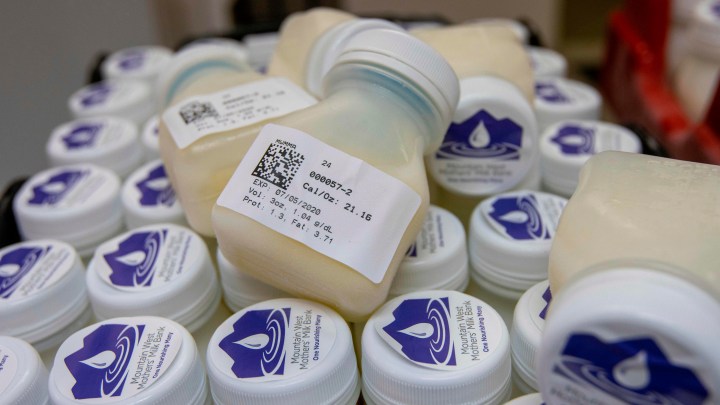
“There will always be a need for donor milk,” says leader of a milk bank
“There will always be a need for donor milk,” says leader of a milk bank

During the pandemic, women have left the workforce at higher rates than men. And when working women are forced to move in and out of the workforce, the supply of donated breast milk can be disrupted.
Donor milk helps nonlactating mothers provide nutrition for their babies, especially preterm babies in the neonatal infant care unit, or NICU. In January, the Human Milk Banking Association of North America released a statement about the urgent need for more breast milk donors to ensure “life-saving medical treatments for high-risk infants.”
“Marketplace” host Kai Ryssdal spoke with Lindsay Groff, executive director at the HMBANA, about the causes of the donor milk shortage.
Lindsay Groff: What we’ve seen lately is that unlike the early days of the pandemic, currently we’re seeing less donor turnout. And that could be for a number of factors. The later pandemic days have different stressors than the early days did. And unlike when we were in lockdown, mothers and babies, parents and babies were close together. That often produces a lot of milk. Those things are changing supply chain issues, and those winter storms have effect on supplies coming into our banks. We rely heavily on overnight shipping to ensure that the milk is kept in a frozen state. So there are a number of factors all coming into play, exacerbated by the pandemic, that really has us calling for people to donate now more than ever.
Kai Ryssdal: I hadn’t even thought about the overnight-shipping thing. I mean, of course, right? It’s, you know, it’s a perishable product. Once the moms and their babies get out of the NICU, or I guess the baby’s in and their moms go home with them, and Mom eventually will go back to work, then that becomes another issue as well, right? Women in the workplace, who have to either if they can’t lactate there, if they can’t express the milk, they have to provide otherwise for their child.

Groff: That’s right. So one of those ways is if a mother’s own milk doesn’t come in right away, say, for instance, she has a medical issue or a baby is born prematurely, donor milk can be used as a bridge so that eventually when her milk comes in, she can provide that milk to her own child. Sometimes what happens is, what we’ve seen when the milk does come in, those mothers who were recipients of donor milk, oftentimes if they’re pumping they find themselves in the fortunate position of being able to provide their excess milk and become a donor, which is a really cool, full-circle moment.
Ryssdal: Yeah. I imagine some part of your staff is in the business of forecasting your needs. What are you guessing as, fingers crossed, we come out from under this pandemic and life stabilizes a bit? Do you suppose your demand-supply curve stabilizes a bit?
Groff: I sure hope that things stabilize. We have new numbers out. So what we’ve seen, we distributed collectively 9.2 million ounces of donated breast milk in 2021, which is a significant increase, 22% actually, from 2020. So you know, we can do the best that we can to predict, but what is constant, just like the blood banks, there will always be a need for donor milk. I’d like to see people continually stepping up to donate to ensure that this life-saving intervention is available for every infant that needs it.
There’s a lot happening in the world. Through it all, Marketplace is here for you.
You rely on Marketplace to break down the world’s events and tell you how it affects you in a fact-based, approachable way. We rely on your financial support to keep making that possible.
Your donation today powers the independent journalism that you rely on. For just $5/month, you can help sustain Marketplace so we can keep reporting on the things that matter to you.











